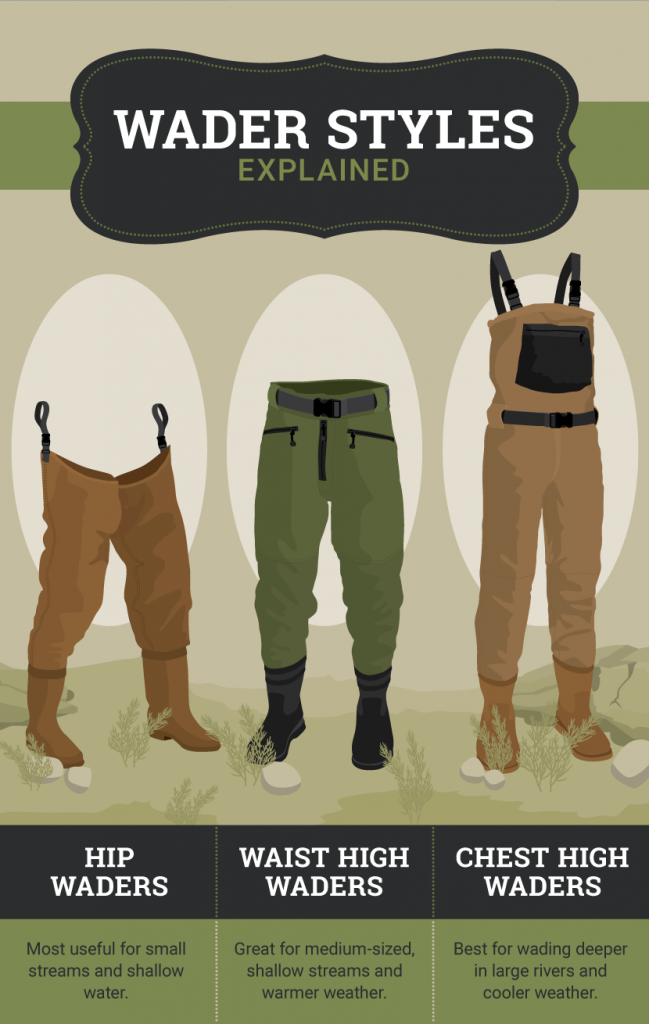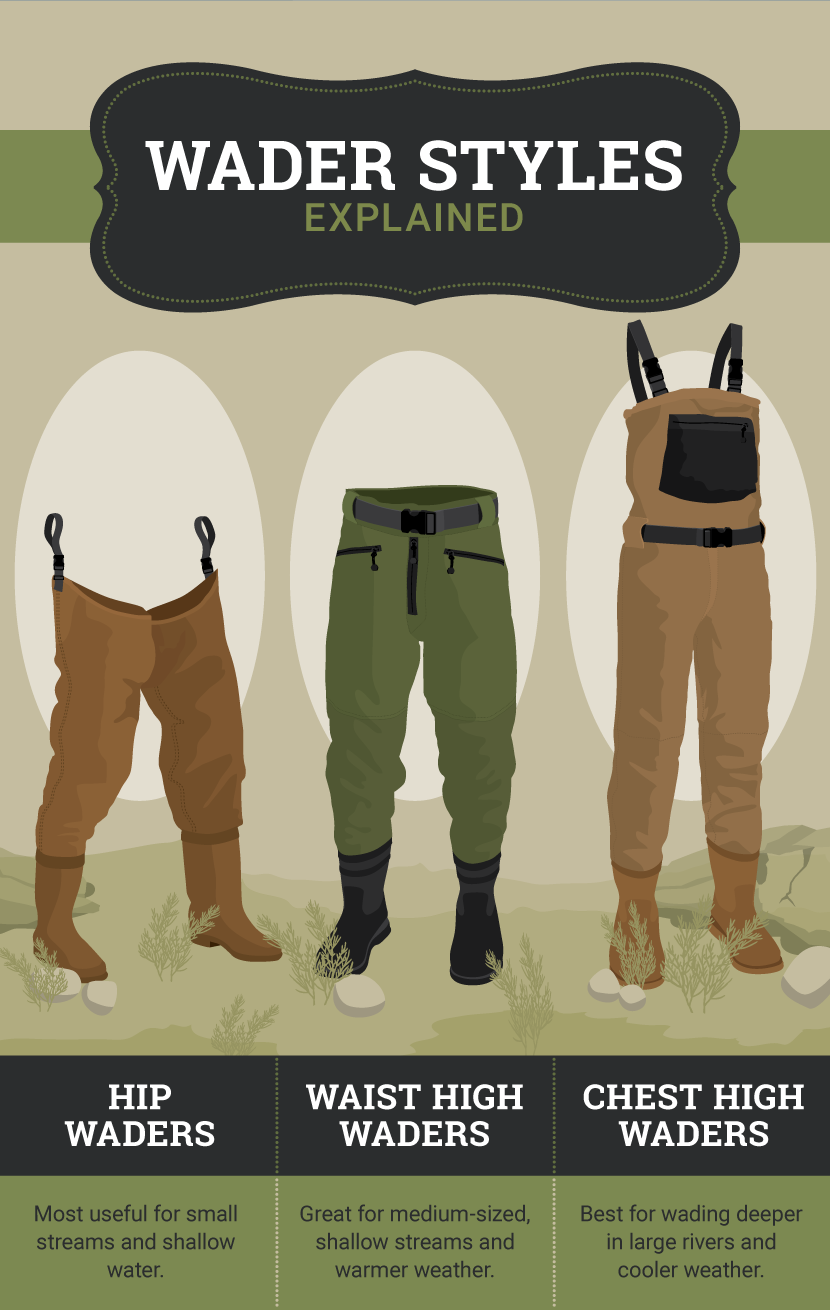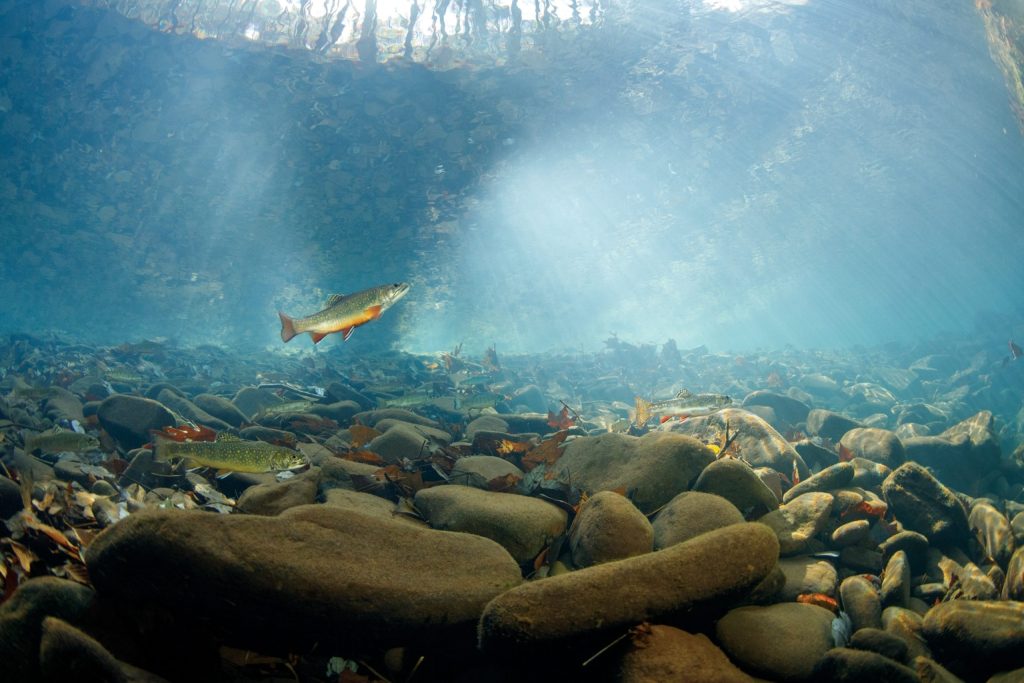To choose the right fishing Wader for Different Fishing Environments, Water Conditions, and Climate. Factor in durability, material, and the type of fishing to ensure comfort and mobility.
Starting with selecting the right fishing wader, it’s crucial to match your gear to the specific challenges and demands of your fishing environment. Anglers must assess various aspects, such as water temperatures, terrain, and the likelihood of encountering abrasive objects or vegetation.
High-quality, breathable materials like Gore-Tex are essential for warm conditions, while neoprene offers superior insulation for colder waters. Durability is equally important, as rugged bottoms can withstand contact with rocks and debris, ensuring long-term use. Chest waders provide maximum coverage for deep waters or when wading into unknown depths, while waist or hip waders might suffice for shallower streams or when agility is key. Comfort is paramount, as you will often spend long hours in your waders; hence, a proper fit prevents chafing and allows for a full range of movement. Wrestling with these considerations will point you toward the perfect pair of waders for your fishing adventures, balancing function, and comfort.
The Importance Of Choosing Wisely
There’s a saying among anglers—the right gear can make or break your fishing adventure. This especially holds true for selecting fishing waders. Your comfort, mobility, and even safety on the water greatly depend on this critical piece of equipment. With various fishing environments in mind, let’s explore how to pinpoint the perfect pair of waders.
Matching The Wader To The Water
The type of water you need ties directly to the waters you’ll explore. Lightweight, breathable waders are ideal for shallow, warm streams. Conversely, cold, deep rivers demand neoprene or insulated options. Let’s dive in:
- Shallow Water: Chest-high waders might be excessive.
- Cold Conditions: Consider thickness and insulation.
- Rough Terrain: Durability is key; opt for puncture-resistant materials.
Weather, Water, And Wildlife Considerations
Assessing the fishing environment ensures you stay dry and safe. Take note of these three Ws:
| Weather | Water | Wildlife |
|---|---|---|
| Temperatures guide wader material choices. | The depth and speed of water bodies influence wader height. | Camouflage can be essential near alert wildlife. |
| Expected rainfall should direct waterproofing needs. | Consider wader soles for slippery or rocky beds. | Extra pockets might be useful for close encounters. |
Whether you’re wading in for bass or casting for trout, know the conditions before you go. Always prepare for weather changes and water level variations. Attune your gear to the wildlife habits in your fishing zone. By matching your waders to the water, and considering the weather, water, and wildlife, your fishing experiences become safer, more comfortable, and, most importantly, more successful.

Credit: www.reeldealanglers.com
Types Of Fishing Waders
Embarking on a fishing adventure means gearing up with the right equipment. Choosing the perfect fishing wader is crucial for comfort and mobility. Different fishing environments require specific types of waders. Let’s explore the variety available.
Hip Waders For Shallow Waters
Hip waders offer superb versatility for anglers in shallow streams and creeks. They are light and easy to maneuver in. Their defining feature is that they extend just up to the thigh and clip to your belt to stay up.
- Ideal for: summer fishing, small streams, and easy access areas.
- Benefits: Provide ample protection without overheating the body.
- Materials: Available in rubber, neoprene, or breathable fabrics.
Chest Waders For Deep Rivers
For deeper waters and challenging conditions, chest waders are the go-to gear. They cover the body up to the chest and often come with suspenders or a belt to secure them in place.
| Feature | Benefit |
|---|---|
| Full Coverage | Keeps anglers dry in high waters and bad weather. |
| Versatility | Suitable for a variety of aquatic environments. |
| Pockets/Accessories | Extra space for tools and personal items. |
Material choices for chest waders include neoprene for colder waters and breathable fabrics for warmer climates.
Material Matters In Waders
Every fisherman knows that the right gear can make or break a day on the water. Choosing the right wader materials is key to ensure comfort, flexibility, and protection in varying fishing environments. Let’s dive into how different materials can suit specific conditions.
Neoprene For Cold Conditions
For anglers braving chilly waters, neoprene waders are the go-to choice. Here’s why:
- Warmth: Insulates even when wet, trapping heat effectively.
- Durability: Resists abrasions and punctures from rocks and debris.
- Stretch: Offers a snug fit, moving with your body as you cast and reel.
Breathable Fabrics For Versatility
When temperatures fluctuate or if you’re hiking to your spot, breathable waders are the optimal choice. Benefits include:
- Comfort: Reduces sweat, keeping you dry from the inside out.
- Weight: Lighter than neoprene, making them ideal for long treks.
- Adaptability: Layers can be adjusted underneath to match the weather.

Credit: en.wikipedia.org
Understanding Wader Fit
As an avid angler, selecting the right fishing wader is essential. A perfect fit can mean the difference between an enjoyable fishing trip and an uncomfortable experience. Let’s dive into what makes a wader fit ‘just right’ for any fishing environment.
Size And Comfort
Finding the right size in fishing waders is crucial for optimal comfort. Consider these points:
- Measure your body: Take accurate measurements of your chest, waist, hip, and inseam.
- Size charts: Use the manufacturer’s size chart to match measurements for the best fit.
- Layering space: Ensure there is room to layer clothes underneath for varying temperatures.
- Boot sizes: Check if the wader includes boots and if the sizes are accurate to your own.
Ease Of Movement
Ease of movement is critical when selecting a wader for any fishing environment. Keep these tips in mind:
- Opt for adjustable straps: They help customize the fit for freedom of movement.
- Test the wader: Mimic fishing movements while trying them on to ensure flexibility.
- Material matters: Pick materials that allow for bending and walking with ease.
Durability And Maintenance
Fishing waders must survive the rough conditions of various fishing environments. Durability and proper maintenance are key to ensure they last season after season. Exploring the right reinforcements and care techniques can save time and money.
Reinforcements At Stress Points
Quality waders come with extra protection where they get the most wear. Look for waders with reinforced knees and a double-layered seat. These areas face the most stress when you move and sit.
| Material | Location | Benefit |
|---|---|---|
| Neoprene | Knees | Cushion and durability |
| Nylon | Seat | Resistance to tear |
Proper Cleaning And Storage
Maintaining your waders is as important as choosing them. After each use, rinse them with fresh water to remove grit and grime. Allow them to dry completely before storage to prevent mildew.
- Hang waders upside down to dry the inside.
- Store in a cool, dry place away from direct sunlight.
- Use a mat when putting waders on to avoid punctures.
Simple steps in cleaning and storage will extend the life of your fishing waders. Maintaining this gear ensures you stay dry and comfortable on your next fishing adventure. Remember, well-cared-for waders can be your best companion on the water.
Price Versus Performance
Choosing the Right Fishing Wader is about balance. Price versus performance plays a key role. You want gear that matches your needs without breaking the bank. But with fishing waders, spending a bit more often means better quality, comfort, and longevity. Let’s dive into what makes for a wise investment or when to snag a budget-friendly option.
Investing In Quality
When it comes to fishing waders, quality should be a top priority. Quality waders offer:
- Durability: They withstand abrasive environments.
- Comfort: They provide a good fit for longer wear.
- Advanced Features: Pockets and belt loops add convenience.
A high-quality wader ensures peak performance in various fishing scenarios. Wade through rocky rivers or coastal waters with confidence. Your investment protects you against leaks and tears, often seen in cheaper models.
| Quality Wader Benefits | Expected Lifespan |
|---|---|
| Material and Build Strength | Many seasons |
| Comfort for Long Hours | Extended Wear |
When To Opt For Budget Options
Not all fishing situations require top-of-the-line gear. Consider cheaper waders if you:
- Are you a beginner angler learning the ropes?
- Plan on fishing occasionally, not regularly.
- Need a pair for guests or backup.
A budget wader can still offer a decent experience. Look for options with essential features:
- Sealed seams to prevent water entry.
- Adjustable straps for a snug fit.
- Solid soles for basic protection.
Select a budget-friendly wader that still aligns with your fishing needs. You’ll find performance doesn’t always come with a high price tag. Yet, don’t sacrifice critical features for the sake of cost alone.
Special Features For The Avid Angler
When selecting the perfect wader, don’t overlook the added features. They can take your fishing adventures to new heights. These special elements provide comfort, convenience, and durability. They make a significant difference in diverse fishing environments.
Built-in Gravel Guards
Gravel guards keep unwanted debris out. They ensure a snug fit around your boots. This protects your feet from sharp rocks and sand.
- Prevents sand and gravel entry
- Decreases wear and tear on waders
- Offers additional comfort for longer treks
Pockets And Accessibility
Hello, anglers! Think of pockets as your onboard tackle boxes. Easy-access pockets mean quick reach for tools and baits. Some waders offer waterproof pockets too. This keeps your gear dry in any situation.
| Pocket Type | Utility |
|---|---|
| Waterproof Zippered | Keeps items dry |
| Fleece-lined Hand Warmers | Warms hands in cold weather |
| Large Front Pockets | Stores tackle and tools |
Evaluating The Fishing Environment
Choosing the right fishing wader hinges on the type of waters you plan to conquer. Think salt spray and surging tides versus calm lakes and babbling streams. Differences in temperature, terrain, and aquatic life demand specific features in a wader. Understanding these environments ensures you stay dry and comfortable, no matter where the fish call you.
Saltwater Challenges
Saltwater fishing poses unique obstacles. Corrosive salt, sharp rocks, and unpredictable waves require durable and resistant gear. When selecting waders for the ocean’s call, prioritize these aspects:
- Material strength to ward off punctures from jagged edges
- Corrosion-resistance to endure saltwater exposure
- Boots with grip for slippery, uneven surfaces
- Sealed seams for extra waterproofing against waves
Freshwater Streams And Lakes
In freshwater scenarios, comfort and mobility often take the lead. Tackling streams and lakes involves different criteria:
- Breathable fabrics for extended wear and walking
- Lighter weights for easy maneuvering
- Adjustable straps for a snug, tailored fit
- Integrated boots or stocking feet to suit your fishing style
Let’s consider the specific needs of these contrasting domains.

Credit: www.reeldealanglers.com
Frequently Asked Questions For How Do You Choose The Right Fishing Wader For Different Fishing Environments?
What Factors Influence Wader Choice For Fishing?
Choosing the right fishing wader depends on water temperatures, wading depth, and the fishing environment’s terrain. Breathability and durability are key to comfort and mobility. Select waders based on seasonal conditions and the type of fishing you’ll be doing.
How To Select Waders For Cold Weather Fishing?
For cold weather, opt for insulated waders that have thermal layers, such as neoprene, to maintain body warmth. Ensure they offer a snug fit to prevent cold water from entering, yet allow for layering clothes underneath for added insulation.
Can Wader Materials Affect Fishing Performance?
Yes, the material of waders impacts fishing performance by affecting comfort, mobility, and durability. Breathable fabrics like Gore-Tex are best for warm climates, while neoprene provides excellent insulation for cold environments. Choose based on the typical weather and water conditions you fish in.
What Wader Styles Are Best For Fly Fishing?
Chest waders are the most versatile for fly fishing, providing deep water coverage and ample storage. For lesser depth, waist waders may suffice. Look for waders with built-in gravel guards and convenient pockets for easy access.
Conclusion
Selecting the perfect fishing wader demands consideration of both function and comfort. Match your choice to the specific fishing environment, ensuring durability and mobility. Remember, the right wader enhances your fishing adventure. Embrace the challenge and enjoy your time by the water with the ideal gear.

